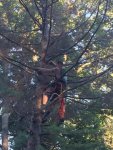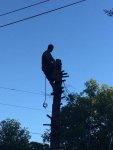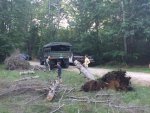I in no way recommend doing the 'winch cable on the ground in a wad and taking off' solution. Many things can and likely will break in the winch, or if it is a mechanical drive winch, the brake can slip as I have had happen with my wrecker. Best to dig around on the opposite side of the fall direction then apply a load. We put a 6" recovery strap in the line, tension it, then work at digging the tree opposite side or in the case of felling it, making the back cut. The strap keeps a tension on it which starts and directs the fall along with the science of your notch. I find I can pull much more with the winch than with driving effort.
To prevent barber chair on a live tree, cut into the sides of the tree inline with where you are going to make the back cut far enough in to get past the live wood. Then when making the back cut inline with the side cuts, do not cut past the innermost penetration of the notch cut so a hinge exists. The even thickness of the hinge left directs the tree fall direction.
One can do lots of interesting things cutting trees, but also get hurt very easily. Dad worked for a lumber company as a feller so I was lucky enough to have his teaching. He was on a crew that was sent along the Kankakee river to cut leaning, curved oak trees out over the river that had the right curve to make keel parts for the ship Admiral Byrd took to the North ice cap region. I am 70, so that as you can imagine goes back a few years and I was not yet around then! A leaning tree can even be jumped over a nearby fence if you do it right. Watch for 'widowmaker' dead limbs above you the vibration of the saw can cause to fall.
All of this about felling is for discussion; you want to uproot these. In sandy soil my M543A2 rear winch has easily pulled out 18" cherry trees with a single block in the line.




